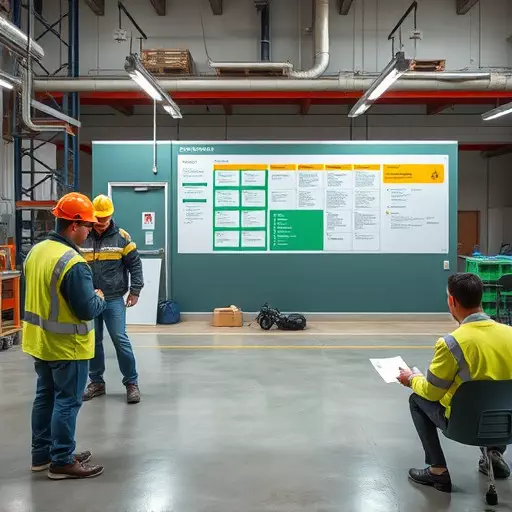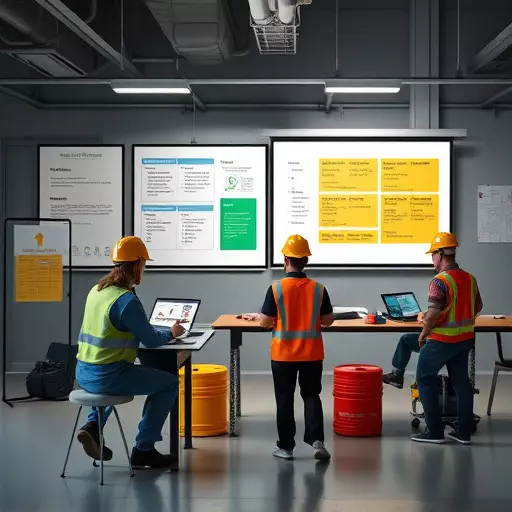The digital transformation in Environmental Health and Safety (EHS) training has significantly enhanced organizational approaches to occupational safety. Traditional manual sessions are supplemented by interactive e-learning platforms, virtual simulations, and mobile apps, driven by evolving workplace hazards and safety regulations. Effective EHS training planning leverages compliance training scheduling tools for efficient organization, participation tracking, and adherence to industry standards. By integrating technology, organizations cultivate a culture of safety awareness, strengthen incident response capabilities, and foster healthier, more productive work environments. This digital revolution in EHS training streamlines compliance scheduling, enhances knowledge retention through interactive learning methods, and enables continuous assessment and improvement for better safety outcomes.
In today’s digital era, leveraging technology in Environmental Health and Safety (EHS) training is no longer an option but a necessity. The modern landscape of EHS training demands innovative approaches to keep up with evolving regulations and ensure worker safety. This article explores strategic aspects of EHS training planning, from digital tools enhancing efficiency to the crucial role of compliance training scheduling in risk mitigation. We also delve into interactive learning integration and measuring success through effectiveness evaluation, all vital components of robust occupational safety training programs.
- Understanding the Modern Landscape of EHS Training
- Environmental Health and Safety Training Planning: Digital Tools for Efficiency
- The Role of Compliance Training Scheduling in Risk Mitigation
- Integrating Interactive Learning into Occupational Safety Training Programs
- Measuring Success: Evaluating the Effectiveness of EHS Training Initiatives
Understanding the Modern Landscape of EHS Training

In today’s digital era, the landscape of Environmental Health and Safety (EHS) training has evolved significantly. Traditional methods of conducting manual, in-person training sessions are being supplemented and, in many cases, replaced by innovative technology-driven solutions. Occupational safety training programs are now incorporating interactive e-learning modules, virtual simulations, and mobile apps to enhance knowledge retention and skill development among employees. This shift towards digital learning is not just a trend; it’s a necessity driven by the dynamic nature of safety regulations and the increasing complexity of workplace hazards.
Effective EHS training planning involves leveraging compliance training scheduling tools that streamline the organization of sessions, track employee participation, and ensure everyone stays up-to-date with the latest industry standards. These tools enable efficient management of diverse learning content, cater to different learning styles, and provide immediate feedback on performance. By integrating technology into EHS training, organizations can foster a culture of safety awareness, improve incident response times, and ultimately contribute to a healthier, more productive work environment.
Environmental Health and Safety Training Planning: Digital Tools for Efficiency

In today’s digital era, leveraging technology in EHS training has become a game-changer for organizations aiming to enhance occupational safety. Environmental health and safety training planning no longer confines itself to traditional methods; instead, it embraces innovative digital tools that streamline efficiency. Compliance training scheduling tools, for instance, enable seamless management of complex training calendars, ensuring every employee receives up-to-date, relevant information. These platforms can automate reminders, track completion rates, and even adapt content based on individual needs, thereby revolutionizing the way occupational safety training programs are delivered.
Digital tools not only simplify compliance training scheduling but also enrich the overall learning experience. Interactive modules, virtual simulations, and mobile applications make EHS training more engaging and accessible, fostering a culture of continuous learning among employees. By integrating these technologies into environmental health and safety training planning, organizations can effectively prepare their workforce to navigate labyrinthine regulatory landscapes, ultimately contributing to a safer work environment.
The Role of Compliance Training Scheduling in Risk Mitigation

Effective compliance training scheduling is a cornerstone in mitigating risks associated with environmental health and safety (EHS) matters. It ensures that all employees receive necessary occupational safety training programs at opportune times, thereby reducing potential hazards in the workplace. With robust compliance training scheduling tools, organizations can streamline their planning, monitor attendance, and track progress, ensuring no gaps exist in critical EHS knowledge dissemination.
These tools offer a systematic approach to managing complex training calendars, enabling companies to stay ahead of regulatory changes and industry standards. By leveraging technology, businesses can implement structured programs that cater to diverse learning needs, ultimately fostering a culture of safety where every employee is empowered to recognize and mitigate risks effectively.
Integrating Interactive Learning into Occupational Safety Training Programs

Integrating interactive learning methods into occupational safety training programs has become a game-changer in the field of environmental health and safety (EHS) training. Gone are the days when static lectures and manual manuals were the primary tools for educating workers about potential hazards and safety protocols. Interactive learning offers a dynamic approach that actively engages participants, fostering better knowledge retention and skill development. This method can include virtual simulations, online modules with multimedia components, or even gamified scenarios that mimic real-world work environments.
By incorporating these interactive elements, EHS training becomes more relatable and impactful. Compliance training scheduling tools can be utilized to organize and deliver these sessions, ensuring a structured and consistent learning experience for all employees. This not only improves safety culture but also helps organizations stay compliant with evolving regulatory standards by providing tangible proof of worker training through digital records and progress tracking.
Measuring Success: Evaluating the Effectiveness of EHS Training Initiatives

Evaluating the success of Environmental Health and Safety (EHS) training initiatives is a critical step in ensuring their effectiveness and long-term impact. This process involves measuring both knowledge retention and behavioral changes among participants. Well-designed assessments, including pre- and post-training tests, can gauge the comprehension of key concepts and regulations. Additionally, observational techniques and feedback mechanisms allow for insights into how employees apply learned safety protocols in practical scenarios.
Compliance training scheduling tools play a pivotal role in this evaluation. These tools facilitate tracking attendance, managing certificates, and identifying knowledge gaps within the workforce. By analyzing participation rates and performance data, organizations can refine their training programs, target specific areas of improvement, and ensure continuous compliance with relevant occupational safety standards. This iterative approach optimizes EHS training planning, fostering a culture of ongoing learning and safety awareness.


